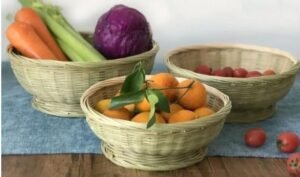Abstract: This paper explores the world of bamboo handicrafts, delving into their historical significance, diverse techniques, ecological benefits, and contemporary applications. Through an in-depth analysis of bamboo as a material and the craftsmanship involved in creating these unique artworks, it highlights the importance of preserving and promoting this traditional art form in the modern era. The paper also examines the challenges faced by bamboo handicraft artisans and suggests possible solutions to ensure the sustainable development of this craft.

Keywords: bamboo handicrafts; sustainable art; traditional craftsmanship; ecological benefits
I. Introduction
Bamboo handicrafts have a long and rich history, dating back thousands of years. These artworks are not only aesthetically pleasing but also hold significant cultural and ecological value. Bamboo, a versatile and sustainable material, has been used by humans for various purposes, including construction, furniture making, and handicrafts. In this paper, we will explore the world of bamboo handicrafts, examining their history, techniques, benefits, and challenges.
II. Historical Significance of Bamboo Handicrafts
Bamboo has been an important material in many cultures throughout history. In ancient China, bamboo was widely used for making writing brushes, scrolls, and other cultural artifacts. In Japan, bamboo crafts such as baskets and tea whisks are highly regarded for their elegance and craftsmanship. In Southeast Asian countries, bamboo is used to make houses, bridges, and various handicrafts.
Bamboo handicrafts have not only served practical purposes but also have had symbolic and spiritual meanings. In some cultures, bamboo is considered a symbol of strength, flexibility, and purity. Bamboo handicrafts often carry cultural traditions and values, passed down from generation to generation.
III. Diverse Techniques of Bamboo Handicrafts
There are numerous techniques used in creating bamboo handicrafts, each with its own unique characteristics. Some of the common techniques include weaving, carving, splitting, and bending.

Weaving is one of the most popular techniques, used to create baskets, mats, and other woven items. Bamboo strips are carefully woven together to form intricate patterns and designs. Carving is another technique that allows artisans to create detailed sculptures and decorative pieces. Splitting bamboo into thin strips or filaments can be used to make delicate lace-like patterns or to add texture to a piece. Bending bamboo is a technique that requires skill and patience, as the bamboo must be heated and shaped without breaking.
IV. Ecological Benefits of Bamboo Handicrafts
Bamboo is a highly sustainable material, making bamboo handicrafts an environmentally friendly choice. Bamboo grows rapidly and can be harvested without causing significant damage to the environment. It is also biodegradable and can be easily recycled.
Compared to other materials such as wood or plastic, bamboo has a lower carbon footprint. It requires less energy to process and transport, and its growth helps to absorb carbon dioxide from the atmosphere. Bamboo handicrafts can also help to support local economies and communities, as they often rely on traditional craftsmanship and local resources.
V. Contemporary Applications of Bamboo Handicrafts
In today’s modern world, bamboo handicrafts have found new applications and markets. They are not only popular as decorative items but also as functional products such as furniture, lighting fixtures, and kitchenware.
Bamboo handicrafts are often favored by designers and consumers who are looking for sustainable and unique products. They add a touch of natural beauty and elegance to any space. Additionally, bamboo handicrafts can be used in eco-tourism and cultural events, promoting local culture and heritage.
VI. Challenges Faced by Bamboo Handicraft Artisans
Despite their popularity and significance, bamboo handicraft artisans face several challenges. One of the main challenges is the competition from mass-produced products. With the rise of industrial manufacturing, it has become difficult for artisans to compete on price and volume.
Another challenge is the lack of access to markets and resources. Many artisans work in remote areas and have limited access to transportation, communication, and marketing channels. This can make it difficult for them to sell their products and reach a wider audience.
In addition, there is a need for training and skill development among artisans. As traditional craftsmanship is passed down through generations, there is a risk of losing these skills if proper training and support are not provided.
VII. Solutions to Promote the Sustainable Development of Bamboo Handicrafts
To address these challenges and promote the sustainable development of bamboo handicrafts, several solutions can be implemented. One solution is to support artisans through fair trade practices and cooperatives. This can help them access markets, resources, and training opportunities.
Another solution is to promote bamboo handicrafts through tourism and cultural events. This can increase awareness and demand for these products, while also promoting local culture and heritage.
In addition, there is a need for research and development to improve the quality and design of bamboo handicrafts. This can help them compete with mass-produced products and meet the changing demands of consumers.
VIII. Conclusion
Bamboo handicrafts are a unique and sustainable art form that holds significant cultural and ecological value. Through their history, techniques, benefits, and challenges, we have seen the importance of preserving and promoting this traditional craft. By supporting artisans, promoting tourism, and investing in research and development, we can ensure the sustainable development of bamboo handicrafts and continue to enjoy their beauty and charm for generations to come.
In conclusion, bamboo handicrafts are not only beautiful works of art but also a symbol of our connection to nature and our cultural heritage. As we face environmental and economic challenges in the modern world, bamboo handicrafts offer a sustainable and creative solution. Let us cherish and support this traditional art form and continue to explore the endless possibilities of bamboo.

Leave a Reply